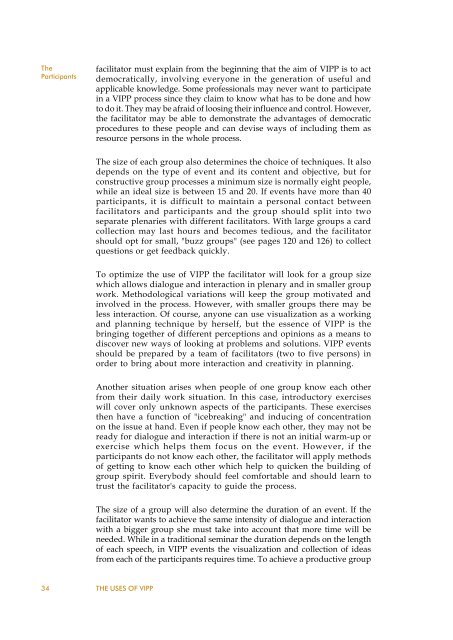VIPP_Unicef
VIPP_Unicef
VIPP_Unicef
Create successful ePaper yourself
Turn your PDF publications into a flip-book with our unique Google optimized e-Paper software.
The<br />
Participants<br />
34<br />
facilitator must explain from the beginning that the aim of <strong>VIPP</strong> is to act<br />
democratically, involving everyone in the generation of useful and<br />
applicable knowledge. Some professionals may never want to participate<br />
in a <strong>VIPP</strong> process since they claim to know what has to be done and how<br />
to do it. They may be afraid of loosing their influence and control. However,<br />
the facilitator may be able to demonstrate the advantages of democratic<br />
procedures to these people and can devise ways of including them as<br />
resource persons in the whole process.<br />
The size of each group also determines the choice of techniques. It also<br />
depends on the type of event and its content and objective, but for<br />
constructive group processes a minimum size is normally eight people,<br />
while an ideal size is between 15 and 20. If events have more than 40<br />
participants, it is difficult to maintain a personal contact between<br />
facilitators and participants and the group should split into two<br />
separate plenaries with different facilitators. With large groups a card<br />
collection may last hours and becomes tedious, and the facilitator<br />
should opt for small, "buzz groups" (see pages 120 and 126) to collect<br />
questions or get feedback quickly.<br />
To optimize the use of <strong>VIPP</strong> the facilitator will look for a group size<br />
which allows dialogue and interaction in plenary and in smaller group<br />
work. Methodological variations will keep the group motivated and<br />
involved in the process. However, with smaller groups there may be<br />
less interaction. Of course, anyone can use visualization as a working<br />
and planning technique by herself, but the essence of <strong>VIPP</strong> is the<br />
bringing together of different perceptions and opinions as a means to<br />
discover new ways of looking at problems and solutions. <strong>VIPP</strong> events<br />
should be prepared by a team of facilitators (two to five persons) in<br />
order to bring about more interaction and creativity in planning.<br />
Another situation arises when people of one group know each other<br />
from their daily work situation. In this case, introductory exercises<br />
will cover only unknown aspects of the participants. These exercises<br />
then have a function of "icebreaking" and inducing of concentration<br />
on the issue at hand. Even if people know each other, they may not be<br />
ready for dialogue and interaction if there is not an initial warm-up or<br />
exercise which helps them focus on the event. However, if the<br />
participants do not know each other, the facilitator will apply methods<br />
of getting to know each other which help to quicken the building of<br />
group spirit. Everybody should feel comfortable and should learn to<br />
trust the facilitator's capacity to guide the process.<br />
The size of a group will also determine the duration of an event. If the<br />
facilitator wants to achieve the same intensity of dialogue and interaction<br />
with a bigger group she must take into account that more time will be<br />
needed. While in a traditional seminar the duration depends on the length<br />
of each speech, in <strong>VIPP</strong> events the visualization and collection of ideas<br />
from each of the participants requires time. To achieve a productive group<br />
THE USES OF <strong>VIPP</strong>


